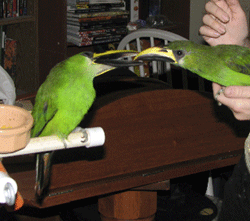Hal
Hal at Play Hal’s Diet Hal’s Plumage: Juvenile vs. Mature
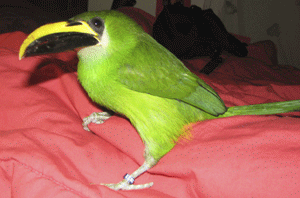
Hal was the first emerald toucanet that my fiance and I got. He is named after Hal Jordan, a character in DC comic books. Hal is a male emerald toucanet, hatched June 8th 2007, and we got him from Emerald Forest Bird Gardens in Fallbrook California.
Picking up Hal was the first time I got to actually see an emerald toucanet in person, however Hal was not the first toucanet I had encountered. A few years before I had met a lady whom had a crimson rumped toucanet which is a very close relative of the emerald. It was really that bird which sparked my interest in toucanets, I remember it being a very gentle quiet and friendly bird.
I had seen a toco toucan once or twice in a pet store before, but that was a very long time ago, and I didn’t get a chance to handle the bird. After meeting my first toucanet I just had to find out more about them, and I and my fiance’s research led us to Hal.
When we picked up Hal from Emerald Forest Bird Gardens, my fiance and I went with a couple whom we are both friends with, and I don't think they had ever even seen a toucan before in person. When we got Hal he was a bit younger than Arisia, whom would all ready mostly have her adult plumage. Hal was a little ball of blueish and greenish fluff when we first picked him up, and though he could eat on his own perfectly well, he still much preferred being fed by hand.
For the first 2 or 3 hours I had Hal there was not a single peep from him, and I began to think there might actually be something wrong with him, I had never had such a quiet bird before. Eventually though he started to utter a little croak or hoot here and there.
Hal went on to be a highly endearing pet to say the least. He loves to play with toys, not only on his own, but with his humans as well. He is also very affectionate, and reminds me of some of the pet dogs and cats I’ve encountered in this respect, he will often fly down onto the couch or my lap so that my fiance or I will give him pets, which he clearly greatly enjoys, and will even sometimes start purring, yes I did just say purring because toucans do purr.
If I’m doing anything around the house my Hal will follow me around and watch what I’m doing in a way that gives the impression that what I’m doing is the most fascinating thing in the whole entire world.
Hal has his own nightly ritual which involves falling asleep on his perch stand generally while watching TV with my fiance and I, and he can become quite frustrated if this ritual is deviated from too much. He also suffers from a fear of the dark, badly enough that he will sometimes hiss and become panicked when the lights go off. This behavior is called night frights, and is not that rare among birds such as cockatiels for example.
Letting Hal go through his nightly ritual and also turning on quiet music and a night light helps keep him sleeping soundly at night. Arisia does not like the dark either, but I have not seen it cause her panic, all though she too will sometimes hiss when the lights go out.
Hal at Play
Hal like most toucans is very playful and energetic. Hal loves to tug a war with rope toys, and when he’s really into this form of play I can even lift the toy into the air with him dangling on it purring.
Hal also loves to chase toys around and this activity can get him very excited. One of his favorite things to chase around oddly enough are plastic bottles (such as empty Odwalla bottles) as well as small cardboard containers, such as those used for milk, or chocolate malt balls, and also cups, especially colorful plastic ones. He gets so excited about these things that I have to be careful about having any full ones around him, because they may end up quickly being knocked over.
If Hal finds a cup or bottle on the ground, he will often fly down to it, and stand next to it looking at me expectantly, which means he wants to play. Make sure that any containers are empty, or have toucanet friendly food items in them before letting your toucanet play with them.
Another form of play that Hal enjoys is catch. I will use the toy pictured here to play catch with him. I simply gently toss this toy to him, and he is actually pretty good at catching it. I believe this behavior is rooted in how toucanets capture prey (typically insects).
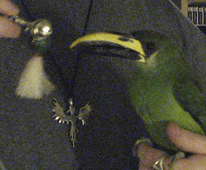
If you have a toucanet you may notice your toucanet also likes to bash their toys against hard surfaces, and this is indeed a technique used to kill prey. Much as with cats and dogs, how toucanets play is rooted to an extent in predatory behavior. Hal also has a rope toy complete with colorful wooden blocks which he enjoys using as a punching (well pecking) bag.
Hal has also decided that all his loose toys in his cage are bath toys, for this reason I don’t give him any loose toys in his cage with metal parts. He dunks them in his water bowl and swishes them around a bit, and then leaves them there. I also wonder if this behavior might have something to do with how toucanets kill prey, or perhaps if they do dunk their food into water in the wild.
Hal’s Diet
The majority of both Hal and Arisia’s diet is comprised of fruit, and Mazuri low iron softbill pellets. Wild toucanets are also primarily frugivorous (fruit eating) however their wild diet also comprises of insects, arachnids, bird eggs, and even on occasion other birds. I do sometimes give Hal certain insects as treats (such as craneflies), and he will get pretty excited when a bug is flying about, and sometimes even catch one on his own. It is important to make sure that your toucanet doesn’t go after stinging insects such as bees, and wasps, as toucans can be fatally injured by a sting. Also make sure they don’t go after critters such as snails, slugs, and worms, or sow bugs (also known as roly–polys) as they may carry parasites which toucans are prone to. Wild emerald toucanets are also known to eat flowers, and I grow hibiscus flowers for Hal which he enjoys as a treat.
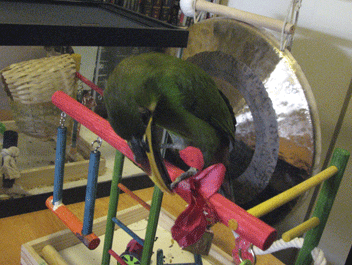
Hal’s Plumage: Juvenile vs. Mature
Before they have gone through their first molt emerald toucanets have different plumage coloration. In this picture you will notice that Hal has a bluish tone to his feathers and that his beak lacks some of the dark coloration that an adult has. After their first molt emerald toucanets gain their mature plumage, and their beak will continue to darken until it looks like that of an adult.
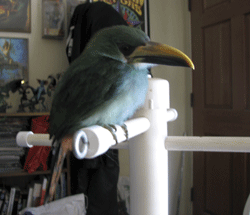
Below is a picture of Hal and Arisia locking beaks flirtatiously.
